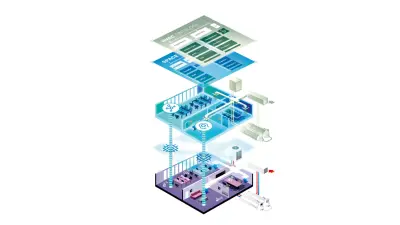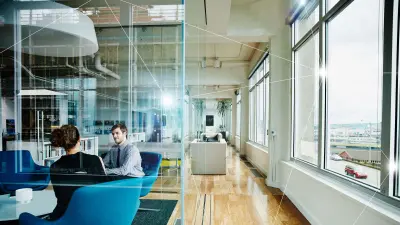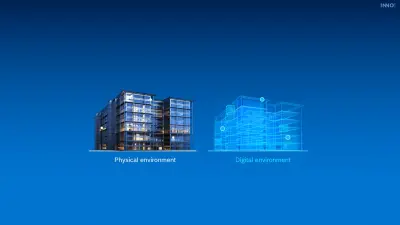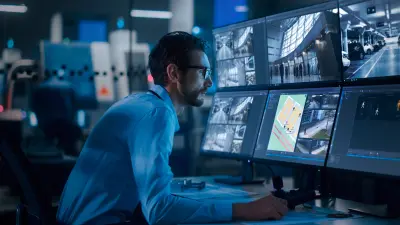When digitalization shows us the way
Data becomes information. Information becomes knowledge. And new knowledge allows new actions: If all data of a building and the underlying building services systems are harmonized, users, operators, and the environment ultimately benefit. The digital building twin from Bosch shows how this can be achieved.
You have an important appointment at 10 a.m., and the way there turns into an odyssey. Lack of local knowledge, no one nearby to ask, no signs to show the way. And then you end up being ten minutes late.
Who hasn't been in that situation?
There are plenty of occurrences of this in daily life. The meeting with your boss in the new factory building, the search for gate 52 in terminal three at the airport, an important customer meeting at trade fair booth 05.127.
A simple, digital indoor navigation system could provide a solution. A service based on different data that has been collated and merged. In a digital building twin.

The "digital twin" offers more possibilities in building management
A digital building twin will make it possible to create a virtual image of a physical building, including the necessary building technology with its systems, devices, sensors, and actuators.
On the basis of this cohesive image, the data packets of individual components can be networked with each other and new services can be implemented. The services can be useful both for creating new business models and for practical everyday help.
Illustration: Semantic model of a digital twin powered by Microsoft Azure Cloud Services
The greater the semantic understanding of buildings becomes, ...
The data required for the services originates from sources such as sensors and systems within building, lighting, and energy management as well as security technology. Up to now, they are often not used together, because in reality all systems, especially in existing buildings, often run independently next to each other and are rarely integrated.
Today’s options offered by cloud gateways and IoT technologies open up opportunities for smart services by combining existing data.
If, in addition, one uses ontology to enrich data into real information, one finally attains semantic data homogenization. In addition to its own domain-specific ontologies, Bosch also makes use of its partners and other market players’ knowledge. These ontologies are made publicly available, because the greater the semantic understanding of buildings becomes, the greater the benefit to the real estate industry.
... the greater the benefit to the real estate industry
The enrichment of different data with information from the digital building twin and the resulting ability to demonstrate meaningful semantic relationships transforms the raw numerical material of the different components into valuable insights for users.
In principle, it’s just like modern navigation in cars:
We used to look up our route in an atlas, work out the estimated journey time with a pocket calculator, and listen to the radio to hear about traffic jams ahead. Today, all this information has been digitalized and consolidated in the navigation system. The system can forecast our arrival time and suggest alternative routes. What's more, we can not only navigate by addresses and places, but also search for the next medium-priced Italian restaurant with a 4.5-star rating or simply look for a popular pizza franchise along our route with a maximum detour of five minutes.
Who would now want to go without this service?
New benefits for owners, operators and users

The digital building twin enables many practical services for buildings.
A maintenance company will in the future be able to predict exactly which component of a ventilation system has already been in use, when and for how long, whether it will behave as expected, or whether, for example, the filter needs to be replaced. On this basis, technicians’ visits can be optimally planned and the necessary spare parts can be ordered automatically 14 days before the visit.
In addition, data on the frequency and duration of use of spaces provides just as many tangible parameters for increasing efficiency as the average temperature control in individual rooms.
Property and facility management also benefits from the consolidation of data from different systems. This creates detailed knowledge about the use of space in the building and thus solutions for space management.
Digitalization also brings benefits to the users of buildings. For example, when an employee passes through the turnstile of his or her workplace’s entrance area in the morning, the office heating is automatically regulated to the desired comfortable temperature. Or when, as a visitor in an unfamiliar building, you are conveniently and easily guided from the underground parking garage to the right meeting room.
Summary
We have only just started exploiting the potential of digital building twins. This is because the number of data-producing components and data-consuming applications is constantly increasing. To take advantage of this, the digital building twin is the ideal way to create the necessary transparency. With its many years of experience as a system integrator and its know-how in the field of IoT, Bosch offers the best basis for seizing this potential and creating new services for its customers.


